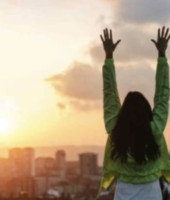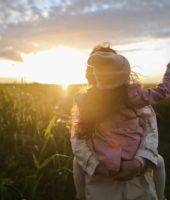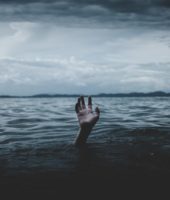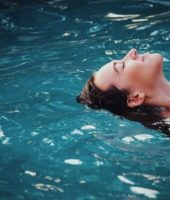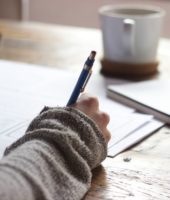I sat down today to write my 277th entry in my “2016 Mindfulness Journal” after revisiting the other 276 entries this past week. My intention is to reflect on how I learned to love myself by articulating the complexity of my emotions from my story, the tools I used to help me get to where I am today, and the lessons I have learned along the way. There were some entries that I wondered, “did I actually write that? I don’t even know who that chick is anymore!” There were some entries that evoked strong emotional responses both sorrow and joy. When I finished, I felt liberated from that incessant voice that constantly shouts, “Do more, you are not enough. Once you reach x, you will be your happiest.” Tool #1: Journaling: Take a moment to reflect, investigate & promote growth. I struggle with articulating my thoughts into words. It all makes sense in my head and I feel like light bulbs are constantly going off, but I have difficulty unraveling the message and meaning behind my thoughts. Journaling has provided me a safe environment to word-vomit anything and everything that is on my mind without pressure, criticism, or feeling like I have to write for a specific audience. It has given me a chance to explore the why. In the why, I found ways to grow, change, and explore my insecurities. I continued to ask myself what it meant to live a meaningful and fulfilling life.
I graduated from Miami University in May of 2015 and continued my arduous journey of becoming a Doctor two months later at Ohio University Heritage College of Medicine–Dublin. Some of my closest friends would describe me as, “the friend that has her shit together.” Hard work has always been one of my top values and strengths. As I entered medical school, I was prepared to work hard, be challenged, and learn. I was told, “You will doubt yourself and question your capabilities… most likely more than once. Just remember, you are here for a reason. If it were easy, more people would go to medical school.” I’m glad I was given the heads up because those thoughts crossed my mind more than a couple of times. The pressure and responsibility of the profession I am training to enter is difficult to describe. Perhaps, something that can only be felt. I wasn’t prepared for that. Medical school soon began to wear on my wellbeing, and as much as I didn’t want to admit it, I was struggling. I was not struggling in the classroom, actually I was doing more than you could imagine. I was scoring exceptionally higher than average on my exams, involved in multiple organizations, volunteering with Special Olympics, working out at least once a day sometimes twice, attempting to eat a restrictive “clean” diet, and date on the side for fun! I was doing everything I hoped; yet, there was something missing and I was suffering from debilitating anxiety. I only heard “Do more. Be more. Be better. Be stronger.”
Lesson #1: Our society has dictated that a successful life is one of power, wealth, and consumerism. I do not have to be a victim. I have the freedom to explore my deepest values & create a fulfilling life.
Lesson #2: I don’t have to do this all on my own. Admitting to myself that I was struggling, not sleeping, and quickly running out of fuel was the first step necessary to elicit change. I chose to seek professional help for managing my anxiety. I chose to use my support system and spend more quality time with my friends and family. Tool #2: Cognitive-Behavioral Therapy. Anxiety, burnout, stress, and depression have become worldwide epidemics. Mental health awareness has been increasing over the past couple of years. I attempt to decrease the stigma surrounding mental health by openly disclosing “I see a therapist for my anxiety.” I try to make light of the situation by making fun of myself in front of my colleagues in hopes that if they too are struggling, they know someone else is right there with them. Working with my therapist has taught me more tools than I can list. It has shifted my thinking and helped me create awareness in my day-to-day life. I understand that my anxiety is a physiological emotional response to my thoughts, which are formed from my beliefs. As my therapist listens to me, he proposes questions that allow me to look at things from a different angle, and connect pieces of my puzzle.
Lesson #3: Pause. Breathe. Gather the evidence that supports this thought and ask yourself if there is more than one way to look at this. Don’t be so quick to react. I found myself falling into numerous “thinking traps.” The most common one I found myself falling into was an “all-or-nothing” thinking pattern, which evolves from perfectionism. I was able to slowly change my thinking patterns by gathering evidence and observing.
Tool #4: Meditation, Mindfulness, and my dearest yoga mat. I could write a novel on this. This is potentially the strongest and most reliable tool I have. I made sure to keep this a daily practice of mine to help manage my anxiety, but I also wanted to use it as a tool to help me build my relationship with myself. Simply put, my practice is about Intention, Attitude, and Awareness. A sticky note taped to my laptop reads, “Set your intention. Cultivate a positive, compassionate, and nonjudgmental attitude. Bring your awareness to your physical, mental, and emotional Self.” Tool #5: Grab a coffee and take a visit to the self-help section of the bookstore. Lesson #4: Reading the books is nice, but try bringing them to life by choosing one thing to work on. Don’t try to attempt the entire book in one day. Don’t do it verbatim. Find something that resonates with you, meditate on it, and attempt to bring it into your life. Some might find this in their religion. I believe a spiritual practice is important in establishing overall wellbeing.
A couple of months into therapy I felt like things were going well. My anxiety had improved immensely. I started to understand my triggers. As I devoted more time to self-reflection, solitude, & my yoga mat, the more I envisioned the life I wanted to live. I challenged my beliefs, wrote about my visions, and decided how I wanted to spend my time in more fulfilling ways. One challenge I faced in that journey was learning how to balance all of the quirks that make me who I am, yet align with my bigger vision. One of my visions included living the healthiest life I could. I originally thought, “To be my healthiest I need to follow a perfect diet & get cut because once I reach that 1. I will happy 2. I will be worthy of a relationship 3. I will be more successful in my career 4. I will be the perfect role model of health. ” As I tried to reach that goal, I suppressed certain aspects of my personality and restricted myself from participating in certain activities. It’s like trying to push five big red balloons down in the pool. You can only hold them down for so long until you fatigue and they burst out of the water and smack you in the face. Lesson #5: Accept yourself for where you are now. See the grace in all aspects of your personality. Be okay with change but stay true to yourself in the process. Be okay with not being okay. I have learned that to be my healthiest I must give attention to all parts of me. I love food: green smoothies and ice cream. I love cooking, experimenting in the kitchen and I love trying new restaurants. I love staying in on a Friday night, lighting a candle, and listening to Bon Iver. I love going out on a Friday night, dancing with strangers on the roof of a bar and then eating greasy Gryos from the street meat vendor. I love being alone and I love being with people. I love my apartment and hanging out with my roommates, but I also love going home and drinking wine with my parents. I love running, yoga, hiking, working out, but I also love having a “lazy day.” I love triple chin selfies, social media, Greys Anatomy, Fetty Wap, The Kardashians, and New Girl. I love turning my phone off and adventuring in the wilderness. My yoga teacher always tells me, “The way you do one thing is the way in which you do everything.” I have found myself in upside down Twerking just as much as I have found myself sitting on a tree stump in the middle of a forest. Staying present & being with the mountain is way in which I try to do everything.
This leads to me my struggle with food and my body. As I became more awake I noticed I was on the verge of relapsing into an eating disorder I struggled with for years. It wasn’t until about four months into therapy that I told my therapist. It took another month to talk to my parents. Another two months to begin treatment. Six months later, I not only have opened up to my support system, but I am here writing publically about it. My stomach turns a little bit to be honest. I hear the voice “DON’T DO THIS, PEOPLE WILL FIND OUT YOUR BIGGEST SECRET… THAT YOU ARE NOT THE FRIEND WHO HAS HER SHIT TOGETHER!!!!!”
Lesson #6: Brené Brown says it best, “Vulnerability sounds like truth and feels like courage. Truth and courage aren’t always comfortable, but they’re never weakness.”
My struggle with food and body image began long ago in a Middle School cafeteria. As my friends, first crush, and I made our way to the lunch line one of my guy friends made a joke about my “thunder thighs” in front of my crush. Of course there were other factors that contributed, but it was around this day that I started to question my weight, self-worth, and my relationship with food. A year later my mom found me throwing up in my bathroom. I began therapy with initial resistance. Side note, hey Mom and Dad thanks for loving me, supporting me, and providing me with the resources to heal. I started outpatient treatment at the Center for Balanced Living in Columbus, Ohio. I had fluctuations throughout the years, but was stable with “normal” thoughts about my body and food as any teenage girl has.
I went off to college where dysregulated eating was the status quo. My priorities were heavily biased towards fitting in and looking good. I graduated college and was determined to lose the extra beer lbs and cut some more by eating extremely “healthy.” I kept telling myself, “To be a good doctor, you need to practice what you preach.” I experimented with different diet styles including paleo, whole-30, whole-food plant based diet, and vegan. Overwhelmed by an abundance of conflicting health claims I couldn’t figure out what the best way to a healthy life meant. I knew restrictive diets were not maintainable and often lead to binges and intense cravings, but I told myself I was different. All I wanted was a healthy relationship with food, yet I didn’t trust myself around food. I would deprive myself until my body had no other choice than to let loose and binge, which led to worse feelings. I used my tools to manage my anxiety but it made me aware that one of my coping mechanisms to escape was food! I began to try to use eating and food as a tool of practicing my will power but would fail miserably. This led to intense fears and anxiety surrounding food choices, my relationship with going home, and I lost the joy I have always found in cooking. To make up for my binges, I exercised more, which led to overuse injuries including a pelvic floor dysfunction, hamstring strain, and lower back pain. I started to think about throwing up and found myself sitting next to the toilet with tears streaming down my face. I felt hopeless, defeated, and frustrated. This wasn’t the life I want to live. Who had I become? I was living with this secret that did not align with my values. I eventually brought myself to open up to my therapist, my parents, and seek treatment again. I started working with a registered dietician who specializes in EDS and works closely with patients in the transition from inpatient/outpatient to the “real world.”
Lesson #7: Self-care is a form of self-discipline. Self-care means properly nourishing my body and soul by pausing to listen to my body’s needs by recognizing my energy levels, emotional cravings, and hunger levels. I deserve to take the time to fill my own cup because it will make me a better person. Tool #6: Sleep. Prioritize sleep. Sleep conquers all. Tool #7: Dating. I had to learn that I don’t need to be attractive to every man I meet. I don’t need to impress anyone. I am worthy of love not because I have a “hot bod,” but because I value human connection, intimacy, and myself. In intimacy, breathe. Be present and concentrate on sensation not “what? Did he just grab my love handle?” I mean, most likely he is focusing on sensation. So chill. It’s cool. Practice communicating what YOU want and need. Don’t take rejection so personally. There are other reasons than YOU. Just because a lot of your friends are in relationships doesn’t mean that is what you necessarily want right now anyways. Do you, girlfriend. Strengthen the relationships you have in present moment and be open to new ones.
Lesson #8: Diets are not sustainable for me. I agree with the scientific literature that a whole-foods plant based diet with minimal meat/animal product consumption is the ultimate diet in promoting longevity, reversing chronic disease, and preventing cancer. Look up the Blue Zones. Clearly, I value evidence. I love food. I love ice cream. I love kale. I value quality over quantity. Colorful plants (Watermelon radishes, rainbow carrots, golden beets I’m talking to you) makes fireworks go off inside of me. I support local and value eating closest to the source. I also like cheez-its. I enjoy sprawling out on the floor of Barnes and Noble perusing cookbooks. You can often find me at the Farmers Markets chatting with the vendors. If I am not there I’m probably eating the Village salad at Northstar or eating Toffee Chip Ice Cream in a Waffle cone at Greater’s. I like to substitute dinner for dessert. Sometimes I have breakfast three times in one day. I’ve learned to listen to my body and that I don’t need to be the perfect eater in order to be healthy. Given my history, I do not believe that restricting foods from my diet will be healthy for me. Rather I will try to eat more plants, whole grains, beans, legumes, low fat greek yogurt and less animal products, but I will not tell myself I can’t have something.
Tool #9: Exercise. Run. Dance. Be outside. Not to lose weight, but because it feels good. Running is one of my favorite forms of moving meditation. It is in the training that the reward is found. “When you give more attention to the doing than to the future result that you want to achieve through it, you break the old egoic conditioning. Your doing then becomes not only a great deal more effective, but indefinitely more fulfilling and joyful” (Eckhart Tolle). Nature and hiking helps spark creativity, energy, and time for reflection. I exercise because it clears my head, gives me energy, and helps me practice mindfulness. I no longer exercise because I need to burn calories. The only right way to exercise is by doing something you actually like.
Lesson #9: Trust the process. I want to practice what I preach because I want to be a doctor that inspires my patients to live healthier lives. My preaching has a different vision: Eating mindfully and kindly, staying active, sleeping, and carving out time for self-reflection, hobbies, and your relationships. My humbling journey thus far in medical school has provided me the chance to explore the parallels of my struggles with that of future patients I might see. For example take a 48-year-old man with alcohol abuse, 30-pack year history, COPD, fatty liver disease, 3 children, a stressful job, and an income below the poverty line. This man’s stress level is beyond anything I could begin to relate to, but I could understand why he would potentially use alcohol and or cigarettes. I don’t agree with his choices because alcohol and nicotine abuse are poor coping mechanisms, expensive, and likely caused his COPD and fatty liver disease. However, I believe it is important to step into his shoes. Empathy, motivational interviewing, and listening might allow me to make progress with his lifestyle changes. Perhaps, he enjoys alcohol, cigarettes, does not value his health, and just does not care. OK. Meet him where he is. His life, not mine. I will listen, pause, and try to understand the why before I act or judge. I will make sure he is educated about his choices, resources, and illnesses.
Tool #10: Medication. After a year of dedication to my health and healing, I feel more myself than I ever have. I have learned coping strategies for managing my anxiety and eating behavior. I have learned ways to improve my lifestyle by managing stress, sleeping, decreasing my caffeine intake, eating well, exercising, and spending time with friends and family. Despite feeling like I was doing my best, I still found myself struggling with low levels of anxiety. I knew how to manage it and decrease it, but it bothered me that it was still there. I originally resisted going on medication because I felt like I could handle it all on my own. Would you tell someone who has a broken foot to just figure it out on his/her own? No. People are wired differently and I could potentially benefit from medication. I don’t NEED it and I most likely could live my life just fine without it. I could try it though and see what happens. If it helps me feel better along with my lifestyle modifications, then why wouldn’t I want to take it? I made a choice for my health to give it a try, knowing that it doesn’t mean I have to be on it forever or that I am “weak.” If anything, I have empowered myself to be a better version of myself.
Lesson #10: I value my relationship with myself. Emotional wellbeing is just as important as physical wellbeing. I value western medicine. I value my human rights to make choices for my health and my body. I value measuring health and self-worth by more metrics than a number on the scale. I value staying true to who I am while remaining curious, open to change, and desiring growth. I value my relationships and beauty in diversity. I have goals and visions for my life and I will take action to try to get there, but I will not lose sight of the pureness in the present moment.
Author: Shannon Flahive
Email: [email protected]
Author Bio: Hi, my name is Shannon! I am a medical student at Ohio University Heritage College of Osteopathic Medicine-Dublin. My specific interests in health include women’s health, preventative care, lifestyle medicine, and nutrition. My research interests include eating behavior, eating disorders, and interventions for preventing dysregulated eating. I completed my 200-RYT yoga teacher training at YogaWorks in NYC. Yoga and Mindfulness are two important tools that I use for my own wellbeing, and I hope to influence my patients and the world by sharing and teaching the benefits of each. Running is my moving meditation. Cooking is my creative meditation. I’m not always that serious and have an obnoxious laugh. Fetty Wap might be my favorite artist—you most likely can find me twerking, dropping it low, and disgustingly sweaty with random strangers on a rooftop dance floor. Did I mention I love food? I’m finally in a place where I have allowed myself to have a healthy relationship with food… finally.
Link to social media or website: https://www.instagram.com/shan.flahive/

